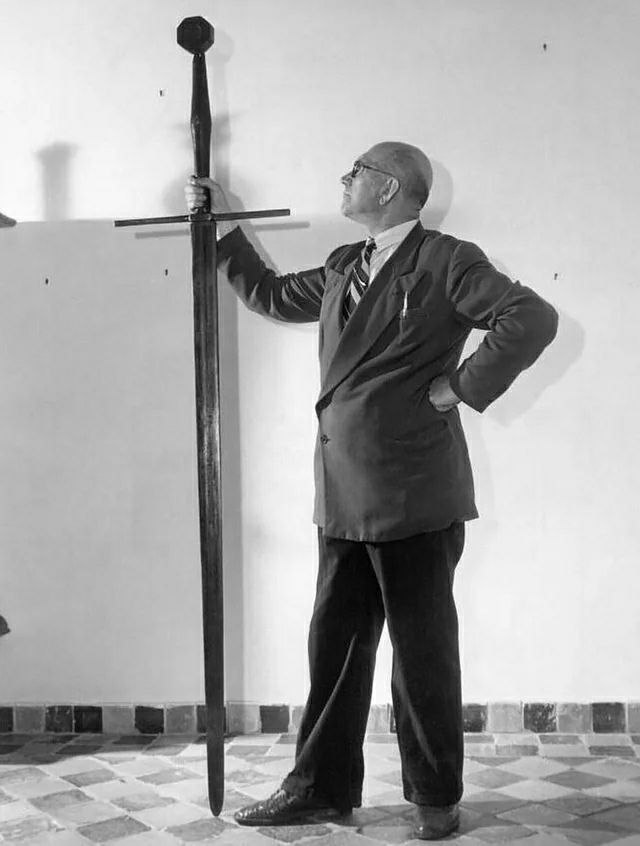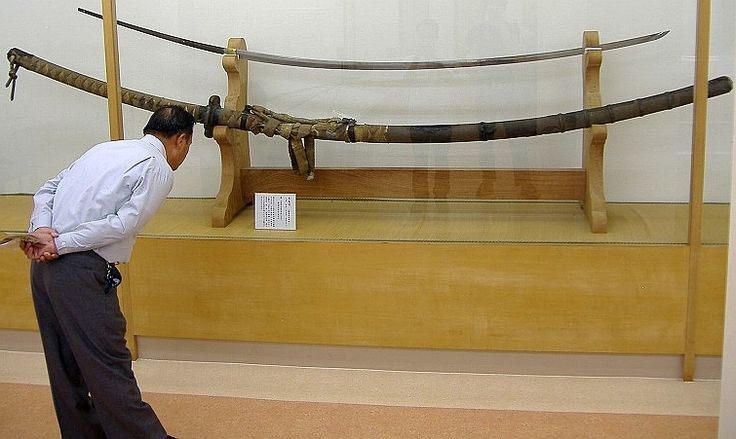Among the many enigmas of human history, few artifacts evoke such awe and confusion as the monumental swords of past centuries.
Towering above the height of the average modern person, these weapons defy conventional explanations — and may, just may, point to an age when giants walked among us.
The Colossal Sword of Grutte Pier: A Glimpse into a Lost World
Nestled within the Friesland Museum in Leeuwarden, Netherlands, stands a relic that stuns nearly every visitor: a gigantic sword measuring 2.13 meters (7 feet) in length and weighing an astonishing 6.6 kilograms (14.5 lbs). This steel colossus once belonged to Pier Gerlofs Donia, better known as Grutte Pier — a 16th-century Frisian rebel leader and folk hero.

Nicknamed “Big Pier,” this legendary figure was said to be as tall as his sword. Eyewitness accounts describe him as:
“A tall man, strong as a bull, broad-shouldered, dark-skinned, with a long black beard and mustache…”
Such a description, preserved by the 19th-century Dutch historian Conrad Busken Huet, speaks not only to his fearsome appearance but to something even more fascinating: his superhuman stature.
But Just How Big Was He, Really?
If we accept the logic of proportional weaponry — where, for instance, a 90–100 cm sword fits a 1.75–1.85 m tall warrior — then a 2.13 m blade suggests a user height of 2.75 to 3 meters (9–10 feet).
While skeptics may scoff, this is not an isolated case.
Two Giant Swords in the Town Hall: Evidence of More Giants?
In 1791, Jacobus Kok chronicled the discovery of two massive swords above the portico of the New Town Hall in Leeuwarden. These were believed to have belonged to Grutte Pier and another warrior, Vijerd Elkama — his comrade-in-arms.
This raises a provocative question: if these massive weapons weren’t ceremonial (and there’s no evidence suggesting they were), were they truly wielded by people far larger than modern humans?
The very idea shatters much of our historical assumptions.
Myth or Memory? Giants in Global Lore
Human folklore is saturated with tales of giants. From the Biblical Nephilim to Russia’s Svyatogor, and from Norse frost giants to Sumerian demi-gods, there is a strange consistency across civilizations that giants once roamed the Earth.
Are these mere “myths”? Or are they distorted memories of a forgotten race of people — beings who may have lived and died in the shadows of pre-modern history?
Oversized Architecture and Artifacts: Coincidence or Clue?
Skeptics explain the massive doors, windows, and ceilings of ancient buildings as simply “aesthetic choices” or “religious symbolism.” But these explanations often fail to account for practicality and recurrence across cultures. Why design a 4-meter door for people barely 1.6 meters tall?
Likewise, if the massive swords, armor, and helmets — such as the huge helmet attributed to Grutte Pier in Sneek Town Hall — weren’t practical for the average-sized human, who were they for?
Enter the Nadachi: The 3.77-Meter Japanese Sword
The story gets even stranger with the existence of the Nodachi, a type of oversized Japanese sword. One particular Nodachi measures 3.77 meters (12.4 feet) in length and weighs an unbelievable 14.5 kilograms (32 lbs).

Forged in the 19th century, this weapon challenges modern logic: what kind of warrior could possibly use this in combat? It’s no ceremonial replica — it’s real, sharpened, and forged with exquisite craftsmanship.
By modern standards, even elite swordsmen would struggle to lift it, let alone wield it effectively in battle.
And yet… there it is, in steel and certainty.
A Forgotten Cataclysm: What Happened Between 1492 and 1502?
Historical records show that between 1492 and 1502, multiple natural disasters and unusual cosmic phenomena were observed and recorded across Europe.
Could this 10-year window mark the end of an earlier epoch, one in which taller, stronger humans thrived?
Many giants of legend, like Grutte Pier, are curiously linked to this twilight era. What if the so-called myths were based on the real-world remnants of a civilization lost during this catastrophe?
Reevaluating History: What the Swords Truly Tell Us
When viewed without bias or modern dogma, these swords challenge every timeline we’ve been taught.
They tell us:
- That larger-than-life humans may have actually existed, perhaps in greater numbers than we assume.
- That legends might carry echoes of fact, distorted by time but rooted in truth.
- That physical evidence — not opinion — should drive historical interpretation.
It’s tempting to dismiss these relics as ceremonial oddities or exaggerations. But doing so avoids the central issue: artifacts don’t lie. People might.
Should We Keep Believing the Same Old Story?
History is written by the victors — and retold by those in power. Over time, truths are softened into myths, inconvenient facts labeled as fantasy. Yet, these giant swords, carefully preserved in museums and temples, defy dismissal.
Instead of ignoring what doesn’t fit the narrative, perhaps it’s time we started asking harder questions:
- Who really built the ancient world?
- Where did the giants go?
- And why are there so many artifacts that don’t fit our sanitized version of history?
You don’t have to accept wild theories — but you should never stop thinking for yourself.

















